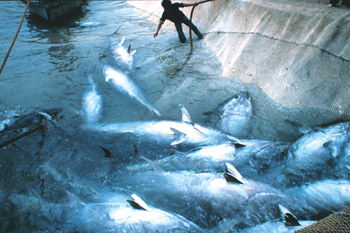Bluefin Tuna Slaughter
EC Blocks ICCAT
by Rich Ruais
|
The International Commission for the Conservation of Atlantic Tunas’ attempt to reign in fisheries for Atlantic bluefin tunas in the Eastern Atlantic and Mediterranean Sea was blocked again by the European Community (EC) at its regular annual meeting in Antalya, Turkey from November 10 through the 18th.
Prior to the start of this years ICCAT meeting, Dr. Bill Hogarth (Chairman of ICCAT and Head of the U.S. NMFS) announced that the U.S. would demand a three to five-year complete moratorium of bluefin fishing in the eastern Atlantic and Mediterranean Sea. The call for the ban was based on the total non-compliance by European and North African fishing countries and fish farms with the 2006 scientific advice presented by ICCAT’s Standing Committee on Research and Statistics (SCRS) that fishing catches had to be reduced to prevent a stock collapse. In 2007 the SCRS advice on the probability of collapse was even clearer given the continuing illegal catches.
Specifically, the SCRS analysis showed that catches had to be reduced from the 50,000 to 60,000 metric ton range to no more than 15,000 mt. In addition, the advice also pointed out a critical need to stop purse seining on spawning bluefins during the month of June. By August of 2007, the evidence was clear that the fishing on spawning fish had taken place to fill the farms, and that catches again were closing in on the 50,000 mt range.
continue
|

The demand for bluefin tuna in Japan has been the driving force behind heavy Eastern Atlantic exploitation of the resource. The US has tried in vain for years to get Spain and other European countries to responsibly manage their end of the fishery. The result is very few bluefin in the western Atlantic. Collapse appears inevitable according to scientists and U.S. fishermen. |
|
|
|
|
The King's Broad Arrow – Pine and Tea
by Mike Crowe
|
This is part one of a two part series.
When trucks roll past these days with a load of scrawny Paul Bunyan toothpick trees, it’s difficult to believe that a primary motivation for 17th century British involvement in North America was the pine trees of northern New England. That pine tree politics may have had as much to do with the American Revolution as had tea in Boston Harbor, does not come to mind either. But the hunting, cutting and the attempted regulation of mast pine was big business and big politics in colonial New England.
There had been some demand for New England masts from the earliest days of boat and shipbuilding. But it was the British Royal Navy’s demand for masts that changed the scale and disposition of the business. As early as the late 16th century, the British Admiralty had recognized the potential of the forests they were about to claim. It was 1652 when the Royal Navy first went to the Piscataqua for their mast pine. Until then logging and masting had been a free enterprise. But wars, naval development and a major London fire at home increased the demand for wood. In response they went to the New England colonies, in particular to the great mast pines, beginning the process of using and controlling the resource.
continue
|
| Felling. The axes were everything. Saws were not used in the New England woods until the 1890s, more than a century after the broad arrow policy. Two axmen cut on opposite sides with the lower, deeper incision dictating the direction of fall. The sharp blades cut deep, throwing large chunks of the soft white pine. There was pride in the swiftness and accuracy of the fall. With skill and judgement, the huge pine crashed into the bedded clearing. If it did not, a mast could be shattered or men killed. |
|
|

